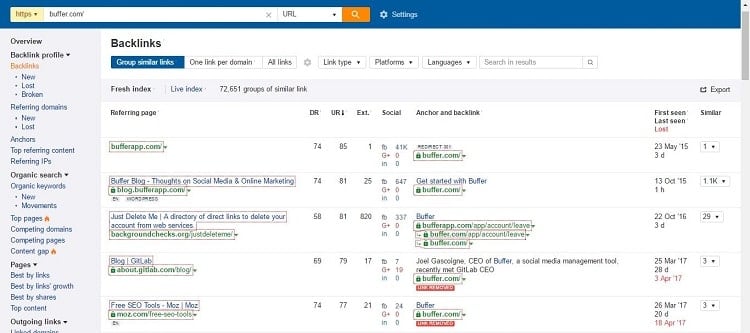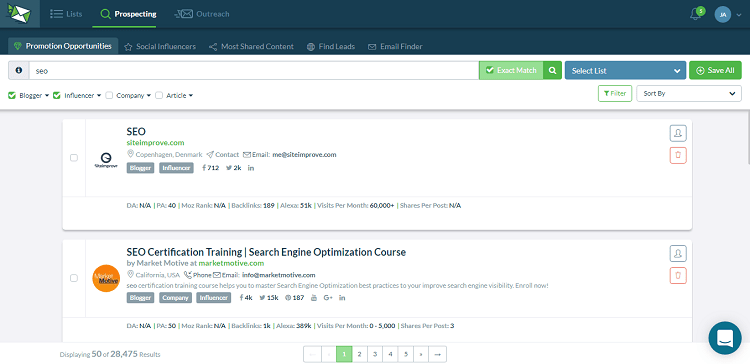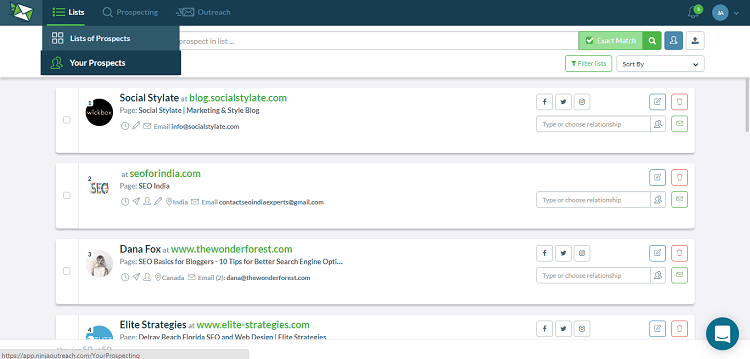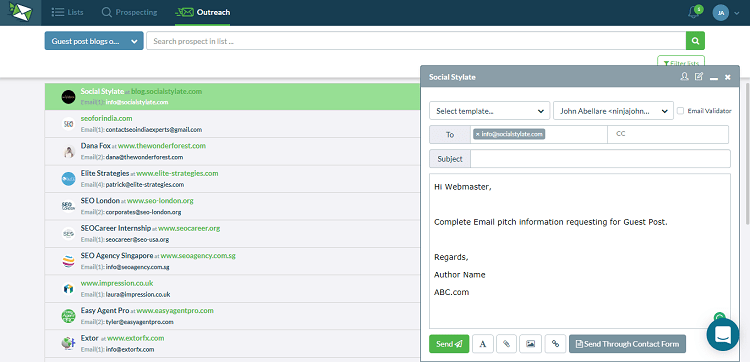Guest blogging is a strategy where you write for other blogs that could help you get enhanced traffic, quality backlinks, and increased brand exposure. Neil Patel has called guest blogging the best inbound marketing strategy.
One guest blogging case study even showed how a blogger generated 30k-plus users for his email list!
Convinced, but overwhelmed at how to start your own campaign, what with all the lengthy tutorials out there?
Below, I’ll take it easy on the too-much-information part and head straight to actionable steps.
Read on as I take you on a beginner’s step-by-step guide to prepare your own guest blogging campaign.

A Beginner’s Step by Step Guide To Guest Blogging
- Preparing Your Guest Blogging Campaign
- Pitching Your Guest Post
- How to Write Appealing Titles for Guest Posts
- Including a Call to Action to Invite Comments
- Writing Your Guest Bio
- The Concluding Step
I. Preparing Your Guest Blogging Campaign
Step 1: Find Guest Post Targets
Before you start writing your guest post, you need to find the right blogs to target. Below are several methods you can take to find these guest posting prospects:
i) Search strings
Performing focused Google search is an art that can help you reach the right people. Here is a list of relevant search strings that can help you get the best of blogs from your niche:
“Search Term” + “Search value parameter”
Keyword + “guest post”
Keyword + “write for us”
Keyword + “guest article”
Keyword + “guest post opportunities”
Keyword + “this is a guest post by”
Keyword + “guest contributor”
Keyword + “want to write for”
Keyword + “submit blog post”
Keyword + “guest column”
Keyword + “submit content”
Keyword + “submit post”
Keyword + “This post was written by”
Keyword + “guest post courtesy of ”
Keyword + “suggest a post”
Keyword + “submit an article”
Keyword + “contributor guidelines”
Keyword + “submit news”
Keyword + “become a guest blogger”
Keyword + “guest blogger”
Keyword + “become an author”
Keyword + “become guest writer”
Keyword + “become a contributor”
Keyword + “submit guest post”
Keyword + “submit article”
Keyword + “guest author”
Keyword + “send a tip”
Keyword + inurl:guest-blogger
Keyword + inurl:guest-post
intitle:guest post guidelines
intitle:guest blog guidelines
ii) Follow the Guest Post Trail of an Influencer in Your Niche
Some writers disclose the other blogs that they write for, and this can ultimately lead you to an exclusive list of quality blogs in your niche.
Below is a screenshot of such a resource page that could give you links to other blogs to guest post for:
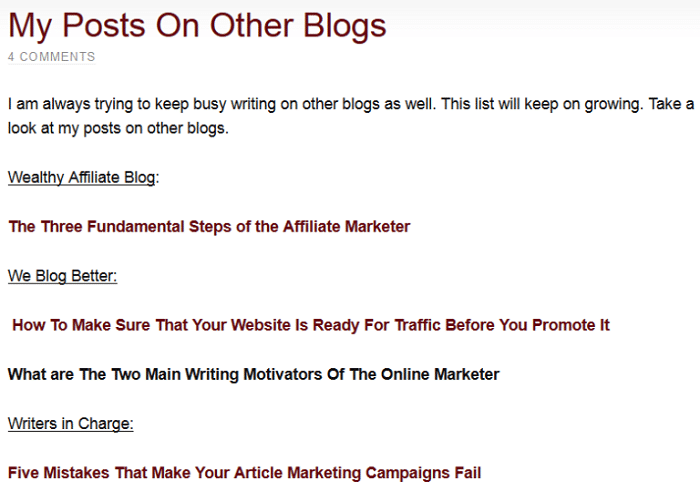
Here are a few examples of search strings you can also use to find more resource pages like the example above:
Author Name + “posts on other blogs”
Author Name + “guest post”
Author Name + “guest blogs”
Author Name + “posts on other blogs”
Author Name + “I’ve been featured on”
Author Name + “sites I’ve written for”
iii) Image Search
Google Image search is another way to find more related works of a target blogger.
Just go to the author bio in a blog post, copy the URL of the author’s headshot, and paste it in the Google reverse image search box.
Hit enter, and you will get a list of sites the writer has also guest blogged for.
Take the example of this Copyblogger guest post by BRIAN CLARK. Scroll to the bottom to find the author bio. Right click the image and select ‘Copy image address’.

Next, paste the image address to the Google Images search bar.

The results will list all the links mentioning Brian Clark, including social media profiles, blogs, and websites. Proceed in the same manner until you build up your list of quality blogs to target your guest posting efforts on.
iv) Search on Social Media Platforms
Using Search strings on social media platforms can yield entirely different results.
For example, you can type “web development + guest post” on Twitter’s search bar to get guest posts on web development.
In the resulting Twitter page, you can single out the best results. You can also use their advanced search feature to refine your search.

Follow the same process on Facebook, Twitter, Google+ and other social media platforms to get some quality results for selection.
v) Reverse Engineering
Use a backlink tracking tool like Ahrefs, RankWatch, SEMrush, Majestic & Moz, etc, to track the top referral link sources of your first and second-page competitors.This reverse engineering method will yield some juicy guest posting candidates. Most of the sites that you will find through this process do not actively invite anyone for guest posting, so it’s harder to find them through usual search strings because they usually don’t have a Write for Us page.
Most of the sites that you will find through this process do not actively invite anyone for guest posting, so it’s harder to find them through usual search strings because they usually don’t have a Write for Us page.
vi) AllTop.com
Alltop.com lists quality blogs from assorted verticals. Just type your keyword on the search bar and click your selected niche in the result that appears next. You may then contact the webmasters to know if they accept guest posts.
You may then contact the webmasters to know if they accept guest posts.
vii) Blog Commenting
Do you often get comments on your blog posts? If yes, it’s a good sign of engagement and an acknowledgment that your blog is actually being read.
So why not go a step ahead and interact with those who comment on your blog?
For example, if someone compliments you on one of your posts, why not ask him or her if they would accept your guest post for their site?
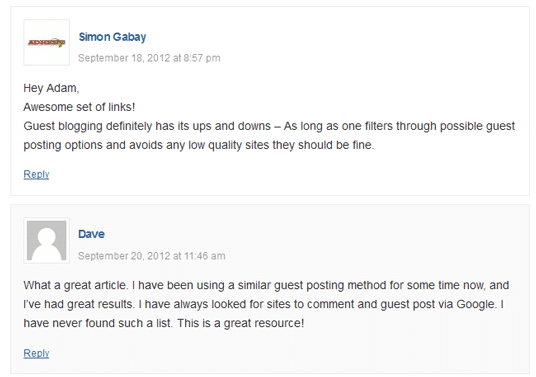
Here’s a template script you can use to reply to comments like the ones in the screenshot above
Hey [Name of prospect],
Many thanks for commenting on my guest post at [Example.com].
I never thought about the fact that [write something they mentioned in the comment box].
That’s indeed a valid point.
I have in fact an interesting guest post idea that could be great for your website. It’s called: “5 Smart Tips for [related topic]”
Just let me know if you feel the idea is good enough. I could sent you the post this week.
Thanks again for your comment!
Best,
[Your name]
viii) Target Lists
A Google search with the right search strings can help you pull up list post type articles on blogs that offer guest posting opportunities. Here are some search terms you can use:
- Keyword “guest posting sites”
- Keyword “accept guest posts”
- Keyword “guest post sites”
ix) Use NinjaOutreach
This super tool helps you speed up your guest blogging campaign by letting you do all your prospecting and outreach tasks quickly, easily, all within a single platform.
With NinjaOutreach, you can:
- Search prospects for guest opportunities areas
- Refine search results for your related niche
- Save leads and categorize them into lists organized under defined campaigns
- Filter out results by number of social shares, comments, and other SEO metrics such as traffic volume, domain and page authority
- Start sending outreach emails, track, and manage conversations from within the same platform
It also has a free chrome extension called NinjaOutreach Lite so you can use some of the tool’s features immediately from your browser, without the need to sign in to the web app.
Below is the prospecting tab, which lets you search according to purpose.
The screenshot below shows how you can use the tool’s Your Prospects tab to search for author prospects.
Once you’ve selected your targets, you can label them under the Add Relationship tab to help you remember the actions you’ve already taken for that particular prospect.
That way, while in the thick of your outreach campaign, you won’t mistakenly send the same outreach to the same person more than once.
The third screenshot below shows NinjaOutreach’s outreach mode. This is where, once you’ve decided to reach out to a prospect, you can simply click on the outreach mode button, and the app triggers a pop-up that lets you label the influencer and write your email. (Take note that you need to connect your email app to NinjaOutreach first)
The tool automatically crawls for the prospect’s email address so there’s no need for you to do it yourself manually. The tool also has templates you can choose from.
Step 2. Zero in on Your Target Blogs
Once you’ve set up your list, your next task would be to filter out the list and retain the prospects that will benefit you the most.
i) Quality Metrics
Several technical aspects play an important role in enabling you target the most worthwhile publishers for guest blogging. Here are top three quality metrics to help you identify the quality of a blog.
- Google Pagerank: Indeed, Google has officially killed Pagerank, its overall authority measuring tool, way back March 2016. However, we still consider it to be among the best tools to measure and figure out page authority and its linking signal strength in order to select for top notch sources. It comes as no surprise that Google itself is still using this tool, which motivates us to keep embracing it. Google Pagerank tool assigns a particular number ranging from 0 to 10 to the websites that it indexes. Sites with higher pagerank are more credible, trustworthy and authoritative. As per Matt Cutts, the Pagerank toolbar considers both the quality and quantity of incoming links to a site. You can check the PR of a site via a PageRank add-on to your browser. Alternatively, you can also visit websites like PRChecker.
- Domain Authority (DA): Established by Moz as a proprietary metric, it ranks the quality of a website on a logarithmic scale ranging from 0 to 100. Like PR, the higher the DA, the better. Online tools like MozBar or Open Site Explorer, Smallseotools, etc. can help you measure the DA of websites. Experts suggest sites with a minimum DA of 40 to target for guest blogging.
- Alexa Score: This analytics site gives you an idea of the traffic that a particular site receives. Just opposite to PR and DA scores, it has reverse ratings, hence the lower score, the better. For example, a site with an Alexa score below 1000 means it has strong traffic.
Other factors like unique referring domains, relevance to your niche, audience interaction, and overall quality of the blog (branding, design, content, online reputation, etc.) also help in effectively choosing a blog to target for guest posting.
ii) Single Out the Seasoned Blogs
After checking quality metrics, it becomes easier to identify the best targets for guest blogging. Below are some more points to consider:
- It should contain an authoritative link profile
- The blog should be relevant to your niche
- It should relate to your blog or website
- The blog’s content should be highly informative and of superior quality
- Make sure the blog can drive qualified traffic
- It places your link in the content body and not in any off-the-focus location
- It should have genuine subscribers (Read: not bots)
- It should have a decent number of followers over social media (again, not bots)
iii) Get Close to Your Targets
After refining your list, the next step should be to get into the good books of the target webmasters before pitching.
For instance:
- Be a Twitter Friend: Interact with them on Twitter at first, and respond to their tweets positively.

- Comment on Their Blogs: React to their blog posts. Contribute valuable insights that could get you in the radar of the blog owner.
- Email Communication: After exhausting the first few outreach methods, proceed to email the site owner. Congratulate him/her for the informative content he/she posted. Shoot this email at least a week or two before pitching for a guest post.
- Find The Perfect Guest Post Topic: After this warming up process, it’s is finally the time to break the ice. You can now submit a killer idea and check out with the webmasters if they would like to accept your guest post about it.
- Send Relevant Posts: Keep in mind that the topic should be relevant enough. It won’t benefit anyone if you send a post on ‘10 tips to be a pro ping pong player’ to a Soccer inspired blog.
iv) How to Choose a Topic
- Outdated Blog Post: Find a reputable site and look for good posts that are outdated. Write a similar post updated with the latest information.
- Go Through Published Guest Posts: Most likely, others should have already written great posts on your niche. Take a clue from these posts and come with a new guest post on a similar topic.
- Try Differently: Alternatively, try to send your target blog a unique post. For instance, if the blog has social media write-ups and already posted two to three articles on ‘Facebook Marketing Tips’, you could provide a guest post on ‘How to become a LinkedIn influencer’.
II. Pitching Your Guest Post
Make an effort to craft a well-written and professional guest post pitch. Below are some outreach practices to avoid.
Don’ts of Guest Post Pitching
i) Unprofessional Subject Line
Avoid excessively praiseworthy subject lines. These would do more harm than good to your reputation.
Some cringeworthy examples below:
- “Looking for a guest blogger? I am your lucky charm. Hire Me!
- Don’t you dare to miss an amazing blogger like me.
- Hey! I dreamt that your blog got a million views on a single day. Guess who wrote that post. Its ME! So why not transform your dream to reality.
Instead, use a straightforward subject line that specifies your intentions clearly. Such as “Request for guest blogging”.
ii) Misleading Email Address in the ‘To’ Line
These types of email ids are no less than suicidal. They can end your guest blogging prospects before starting. Please don’t use them if you want to go pro.
Some cringeworthy examples below:
The best email address should ideally have this format: [email protected]
iii) Addressing an Unknown Recipient
Forget about starting your mail with lines like “To whom it may concern” or “Dear concerned”, etc. A simple “Hi” followed by the name of the webmaster would be fine. For example, “Hi Peter”.
See below for an example template.
Hi [name],
I’m a long time reader. You may have noticed my comment on your post on [name and link of blog post] — (awesome article, by the way).
I am one of your long time readers. You may have checked out my comment on your post on “Smart tips for [name and link of blog post]”. It’s indeed a great write-up.
Inspired by the quality posts on your website [Example.com], I would also like to contribute to it as a guest blogger.
I have already been thinking about some interesting topics that would be valuable for your readers. Here are few selected ones:
-Topic #1
-Topic #2
-Topic #3
I’ll make sure the piece provides all the valuable information that the readers would find hard to get from anywhere else.
Just to give you an idea of the quality that I could introduce to your website, Here is a recently published guest post on [Example.com].
Cheers,
[Your name]
====
Let’s dissect this email template:
- It kicks off with something specific about the target blogger’s site.
- It is concise (wrapped within 150 words).
- It makes it easier for the blog owner to choose from among the proposed topics.
- Helps the latter to get an idea of your experience and published posts.
Here is another good example guest blog pitch from a Udemy Instructor:
iv) Not Going Through the Guidelines
There is no better way to show respect to your target blogger than by reading the guidelines of their website (if there are any).
Nothing instantly destroys a good guest posting opportunity than an outreach email or submission that blatantly defies the blog owner’s guidelines.
Take note if the webmaster wants you to pitch an idea first, or directly submit a complete post. There might be certain guidelines about the format of the post, topic preferences, linking guidelines, and so on.
III. How to Write Appealing Titles for Guest Posts
Step 1: Recall Your Previous Successful Posts.
Adding a numerical touch to the title is usually a winning recipe
- Top 10 points that make your content better
- 15 ways in which you could become a social media celebrity
- Here is how 10 studies prove that consisting blogging make you a popular writer
For more examples, the image below from coschedule compares the best performing and worst performing titles.
Step 2: Use Psychological Turn-ons
As per research by blogging experts, titles that could trigger the emotions of the readers are most likely to succeed.
For instance, Neil Patel talks about five key elements that help the guest posts to get maximum shares on social media: Curiosity, Amazement, Interest, Astonishment, and Uncertainty.
Step 3: Use Specific Words That Could Stimulate the Reader Straight Away
Using certain words have the tendency to enthrall the audience.
For example, words that prompt one to take an action or speak about the quality of a service, like ‘affordable’, ‘download’, ‘exciting’, ‘interesting’, etc
The free guide below gives you top 500 words that create a stir among the minds of the readers instantly.
Step 4: Use Templates to Write Headlines
Several websites like Copy Hackers, Michael Hyatt, Crazy Egg, Copy Blogger, Jeff Bullas, Brain Traffic, etc., provide you with useful headline templates.
If you are running out of ideas, these custom-made headlines can help.
Here are few template examples:
- What {#} Studies Say About {Subject}
- How To {Verb} Your {Noun} For Massive Growth
- Do You Have The Courage To {Do Something Desirable}
- The secret of _________________
- The Ultimate Guide To ____________
- How To Rock A {Noun} That Will Save You Tons Of Time
Step 5: Use Headline Generator Tools
Below are some blog title generators from authority websites.
IV. Writing Your Guest Post
Writing a guest blog requires you to set a goal before proceeding. There is an end goal to writing content for other sites. You either guest post to establish yourself as a trustworthy resource, gain subscribers, anticipate business opportunities, and so on.
Setting S.M.A.R.T goals strategy (Specific, Measurable, Attainable, Relevant, and Time-bound ) is something you should look at.
Step 1: Define Your Approach
Before writing your guest post, you need to be clear about your approach. Determine the pros and cons and the resources you have to write a tutorial, an ultimate guide, a detailed case study, or concise step-by-step guide.
Step 2: Background Research
A thorough background research is par for the course. So as not to appear amateur, stop talking about what you think should be done and instead, support statements you make in your guest post with relevant case studies.
The Importance of Case Studies
Any article worth its salt should be supported by strong, authoritative sources, and case studies make for compelling support. Adding this sort of backup to you article’s arguments make your statements more believable.
For example, you can say with more authority that clearer email subject lines lead to more opens if you have a case study example where you find that 80% out of the 3500 emails you send per month for a period of 1 year showed you this data.
In one of his posts, Bamidele Onibalusi of the WritersInCharge blog shares details about his own guest posting strategy. He cites each of his own guest posts as each case study and complements with screenshots of their Google Analytics stats, thus showing how these guest posts contributed to the massive growth in his audience. Also, he notes that most of his example posts that did really well are case study type articles.
A case study article about how well case study type articles performed. How meta!
Step 3: Including Screenshots
Say (and prove) more with images instead of words. Instead of simply saying something happened or is true, screenshots of your step by step processes are better. There are various free tools online. Some of which I would recommend are Snipping Tool (Windows, Free), Skitch (Mac, Free), and Jing (Windows/Mac, Free).
V. Including a Call to Action
Don’t forget to include an appeal or call to action for comments. Engagement will help increase the visibility of your guest blog.
VI. Writing Your Guest Bio
Provided the blog you are guest posting for allows it, your guest bio is where you can promote yourself, your website, or put in links that are important to you.
For example:
- Provide a backlink to your website if your aim is to get quality backlinks
- If you want decent traffic, include the link to your custom landing page or the product page.
- If you want to increase your followers, include an appeal to the concluding line of your bio, which says “Follow me on [mention your social network profile link].”
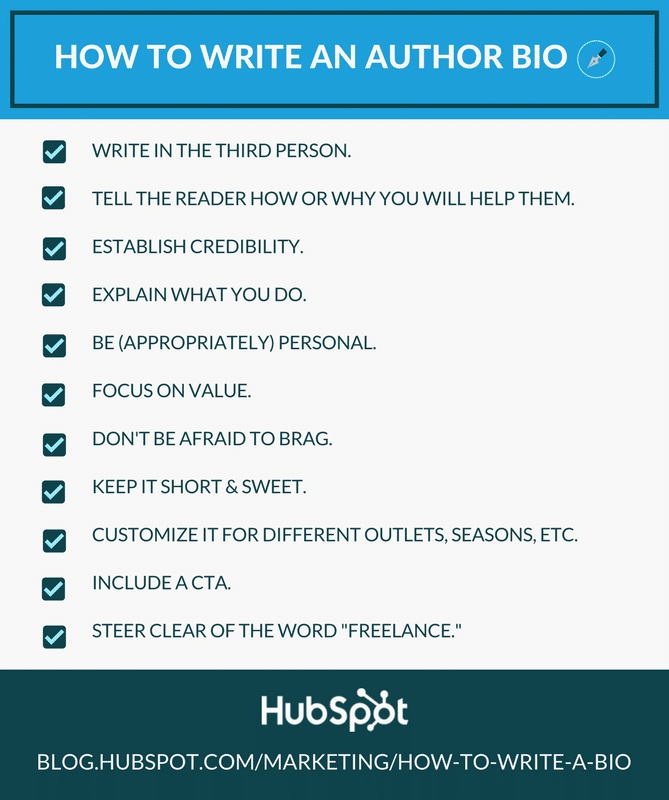
VII. The Concluding Step
If you get published, congrats! But your job doesn’t end there. Most guest blogs appreciate a writer that can not only deliver content, but engagement as well. So, don’t forget to:
1. Share on Various Social Media Platforms
Share your guest post on all the major social media platforms like Facebook, Twitter, LinkedIn, Reddit, etc. You can share the blog with your email subscribers and request close contacts to share it on their personal profiles.
2. Respond to Comments
Interact with your readers. Identify the readers who comment on your blogs regularly. Visit their profile, browse through their blogs, and find out any post relevant to your niche. Leave behind a thoughtful comment on their post to ensure a two-way engagement.
So there you have it, a beginner’s step by step guide to guest blogging. Should you wish to add to the tips already mentioned here, you can always type in your suggestions in the comment box. Until then, Happy Guest Blogging!
Ram Babu is a Digital Marketing Specialist at Techies India Inc. and is a Technical Search Contributor at RankWatch, one of the prominent SEO tools among digital marketers. He owns SEOBookLab.com and is also SEO Manager for Code&Co, Big Slate Media, and Agile Continental. Follow Ram at @RamBabuSEO.


